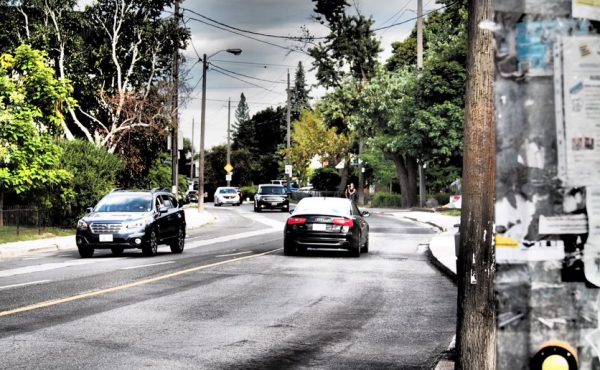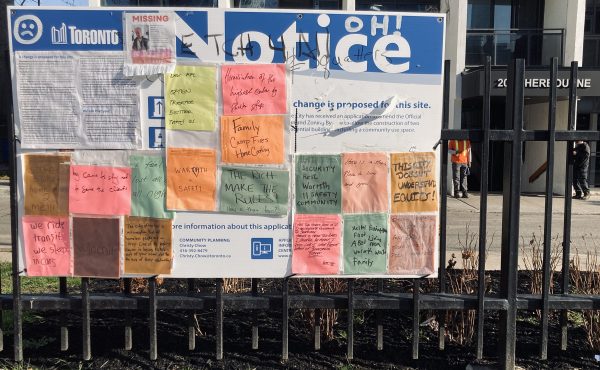
WASHINGTON DC — At the risk of turning this blog into Spacing DC, I’m going to share a few more public space-related photographs from my recent trip to Washington.
First up is the “No gridlock (please)†sign (pictured above) just three blocks east of the White House. What the sign intends to say is “Do not block intersection.†Instead it provides humourous insight into American public policy. Even scarier, in my mind, is that the Harper Government seems intent on mimicking the Bush Administration so frequently that Canada’s national transit strategy may turn out to be a series of “No Gridlock (please)†signs. (Actually, in fairness to the US, they have a functional national transit strategy that Canadian cities would be lucky to have seeing as here we have no strategy.)

“Red light running†with a slash through it made me laugh out loud. If a driver isn’t going to stop for a red light, what will a wordy sign a few feet lower do? It’s a truly sad commentary on the people of a city if their elected leadership feels it necessary to demean them with a sign like that.

Maybe this is the Yellow Cab Company’s attempt at humour but yellow this cab is not.

More impressively, the picture above shows a public art work outside of the Corcoran Gallery of Art. It may never make it into the gallery itself, but patrons have affixed colourful visitor badges to several posts outside the Corcoran.

Here is a pedestrian countdown at 41 for a two lane street. It started at 59 and the flashing hand began going at 15. Starting the countdown with the beginning of the light seems like an asset for pedestrians so why not try it here?

In front of the White House is a very conflicted space. The presidential palace and the blocks surrounding it are crawling with police and not-so-secret Secret Service officers. As an added security measure, no unauthorized vehicle is permitted to enter the road in front of 1600 Pennsylvania Avenue. That leaves a vast four lane road more or less free for pedestrians and cyclists. Yet very few people actually use it as most keep to the sidewalks, unsure how jaywalking laws are enforced in this grey area.

This sign advises that you’re being monitored by police.

The turquoise sign advertises a charter school. As a Torontonian, I hear the word school and I associate it with more than just classrooms. Schools include playgrounds, parks, soccer fields, baseball diamonds and basketball courts. In Washington there are fewer traditional public schools because charter schools (autonomous schools that receive public funding), which are generally just a few rooms in a commercial building, were determined to be the solution to a local school board that was perceived to have failed to meet the needs of its students.

Fair representation in congress has long been an issue for Washington residents. This sign appeared in a planter on 14th Street.
No Red Light Running photograph by KimberleyJane24. Pennsylvania Avenue photograph by dmolsen. All other photographs by Adam Chaleff-Freudenthaler.




7 comments
I believe the reason ped countdowns don’t start at the beginning of the light is that the light isn’t “committed” to turn red until later in the cycle — if there’s no cross-traffic or walk button presses, it could stay green indefinitely. A full countdown would be feasible for busy intersections (where the odds are almost 100% the light will turn every cycle) but then you have inconsistency.
The US relies heavily on wordy street signs, e.g. they use “Right Lane Must Turn Right” where we have a simple white arrow on a black background. Bilingualism can make things simpler… 🙂
So, if an intersection lacks a “[No] Red Light Running” sign, does that mean that it’s okay to run the red light? It must! Spread the word.
Based on the behaviour I’ve been observing, the rule seems to be that it’s okay to go through an intersection on a red if:
1) you are directly behind another vehicle that has sped through on a yellow — the rule of Tailgater Equivalence, under which your only duty is to obey the brake lights of the car in front, barely visible over your hood.
2) you go really fast — the Nobody Saw That principle, combined with the doctrine of Greater Recklessness.
Remember: driving is a game, and if you have to stop your car, you lose.
The U.S. also has a high speed rail corridor in the densest part of their country.
The Acela Express is not high speed rail. It is a tilting train, running on regular train tracks, that can run up to 241km/h on a very short section of track – but it usually runs at about 200km/h or less. Real high speed rail runs on dedicated track at 300-320 km/h – for that, you have to go to Europe or Japan.
Amen on the Acela–it’s a bit better than the utterly shambolic Regional trains (which are, much, much, much worse than VIA), but high-speed rail it ain’t. Incidentally it’s my own former home, Connecticut, which has been the worst foot-dragger on upgrading the rails to high speed standards. Through that portion of the trip the trains can really crawl.
New Jersey, which is surprisingly progressive on some transport issues, took care of its segment.
It’s not a model to follow, but the lines are electrified, and their speeds beat what we have. It’s more invested in. 200 kph can be considered high speed, but it’s the lowest end of the spectrum.
The “Red Light Running” sign isn’t another “please” statement; it’s a warning that the red light is photo enforced.
The USA has a transit policy? That’s news to me — please note that almost every single one of our major transit systems is (a) skeletal and (b) underfunded to the point of no return. Yes, we, too, lurch between budget crises.